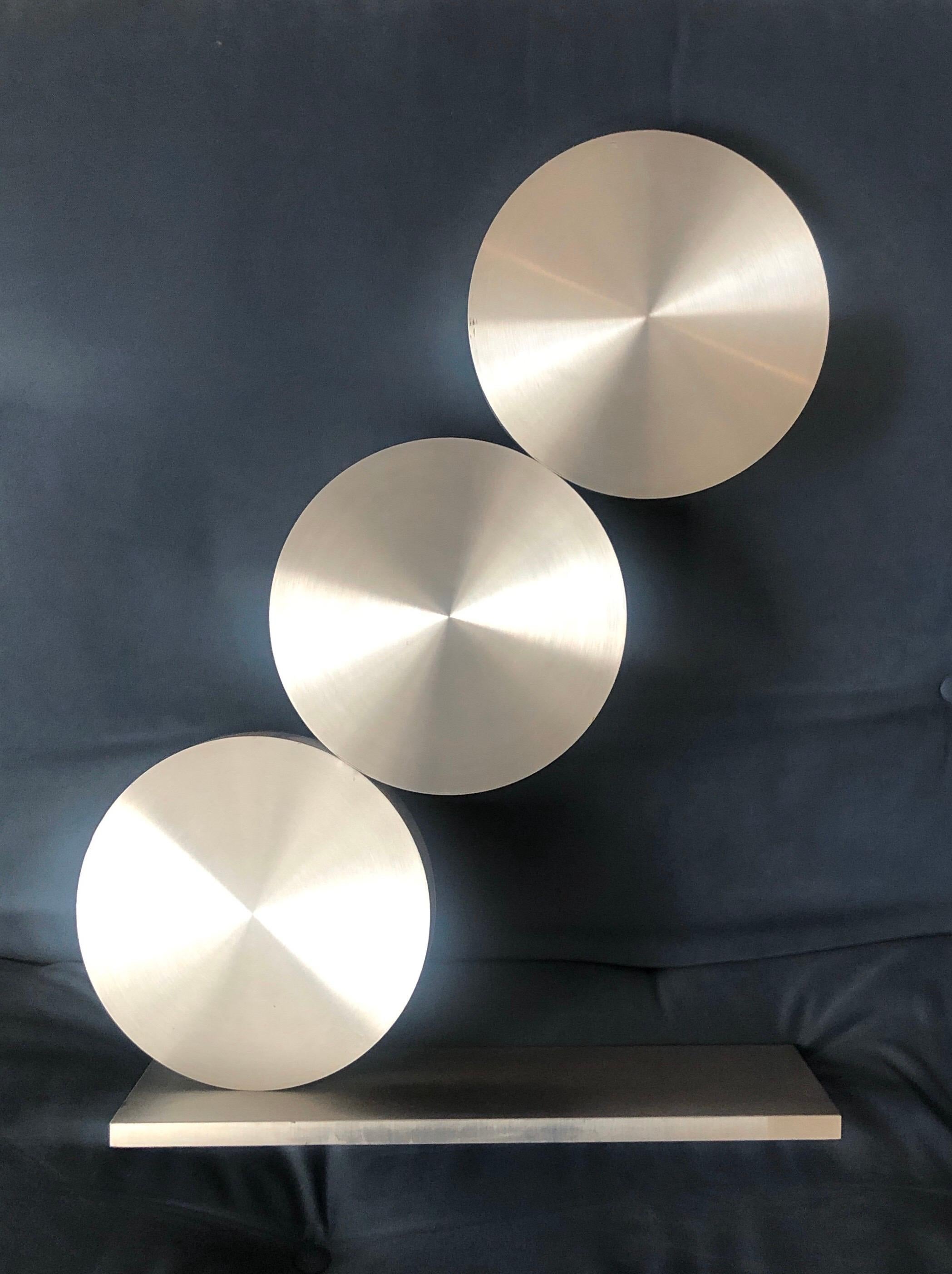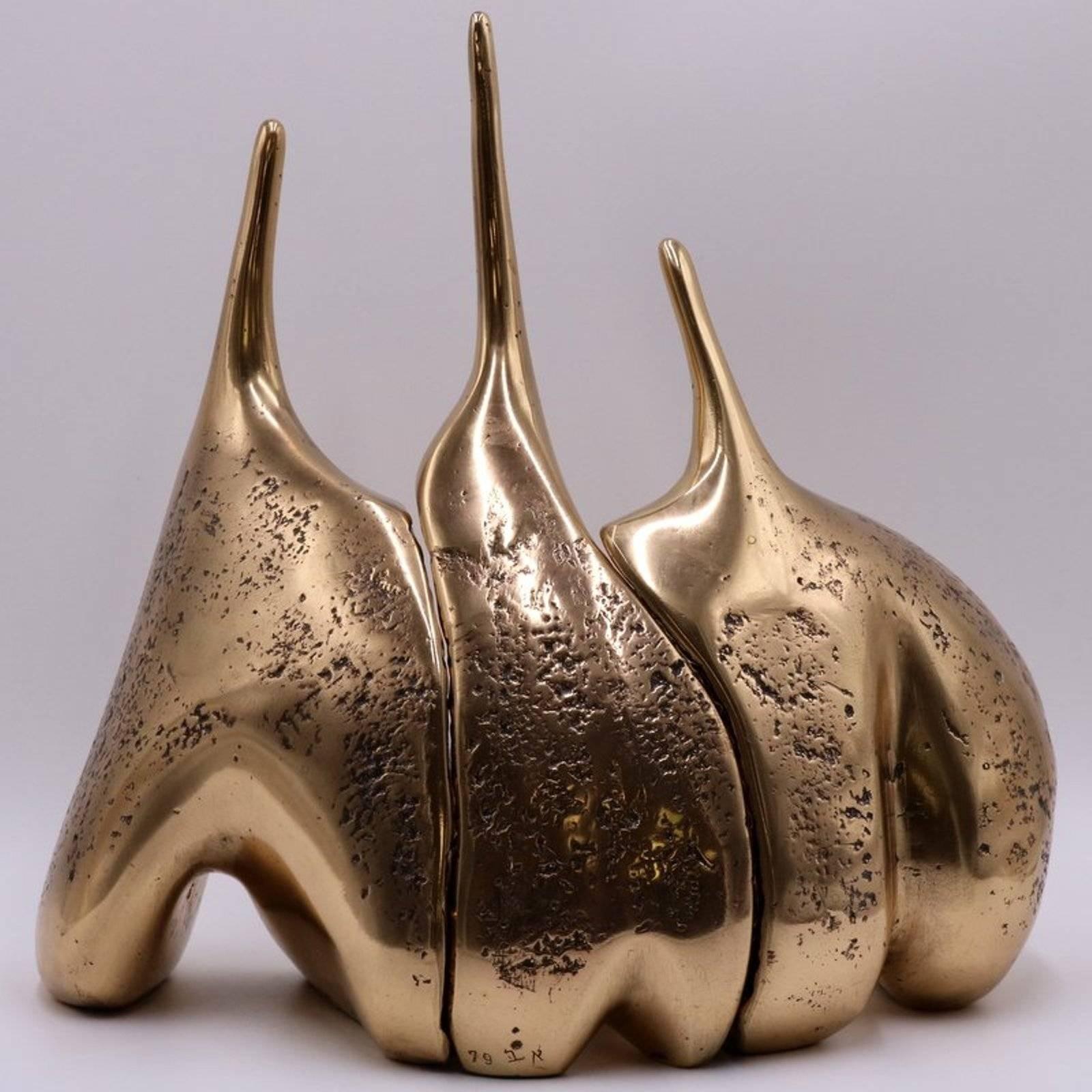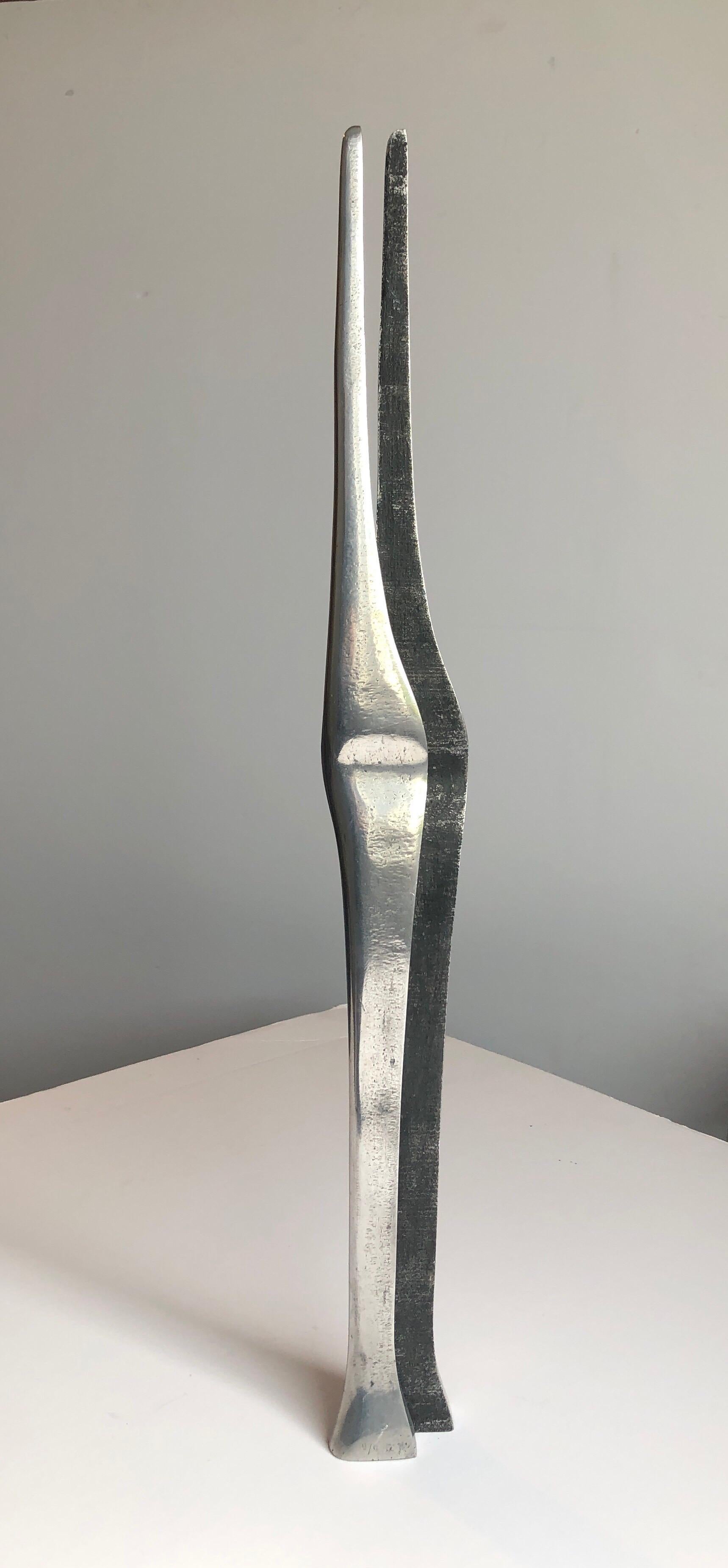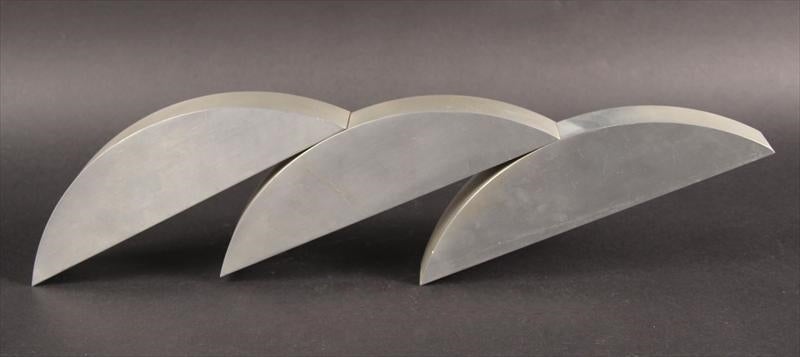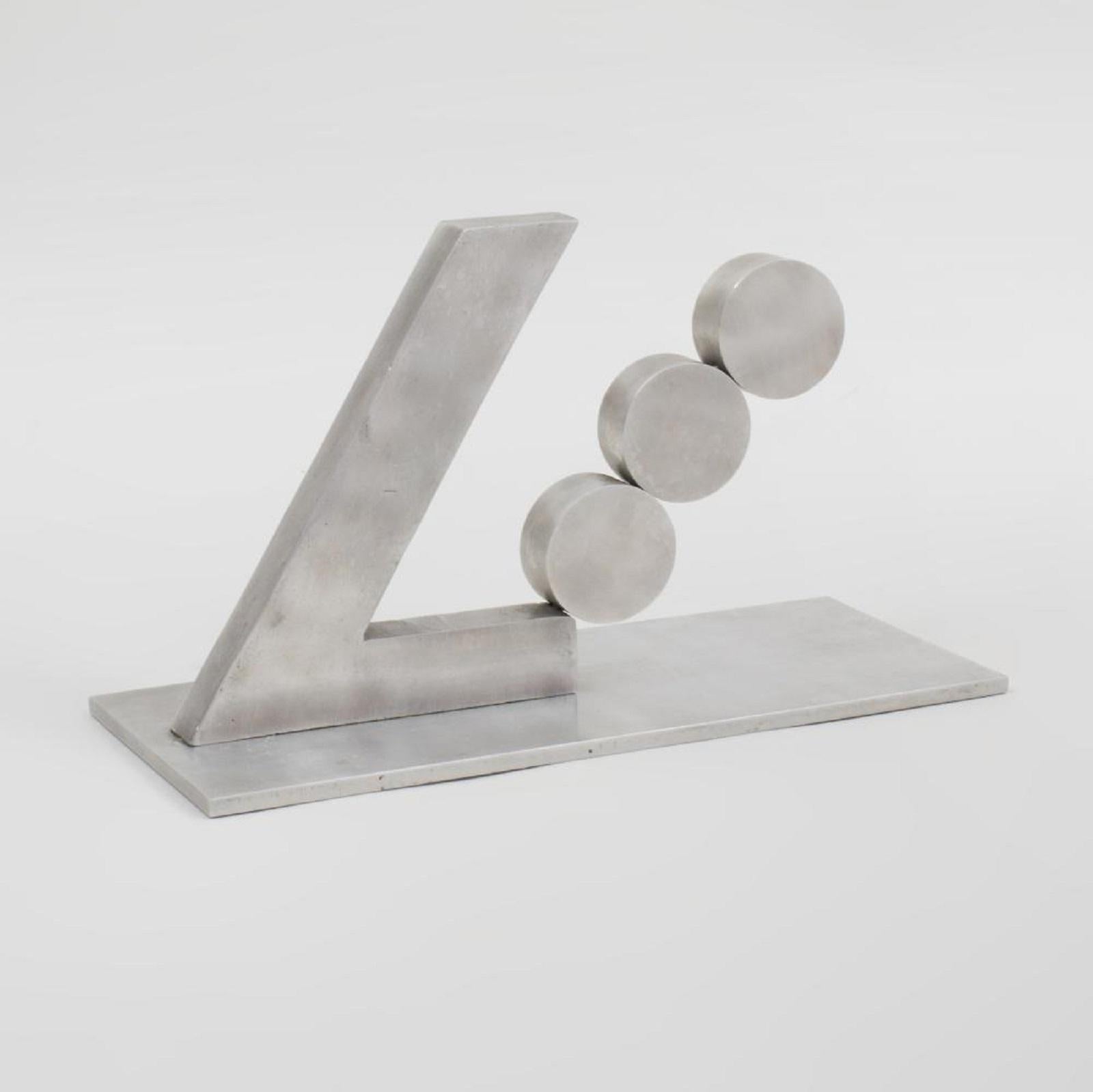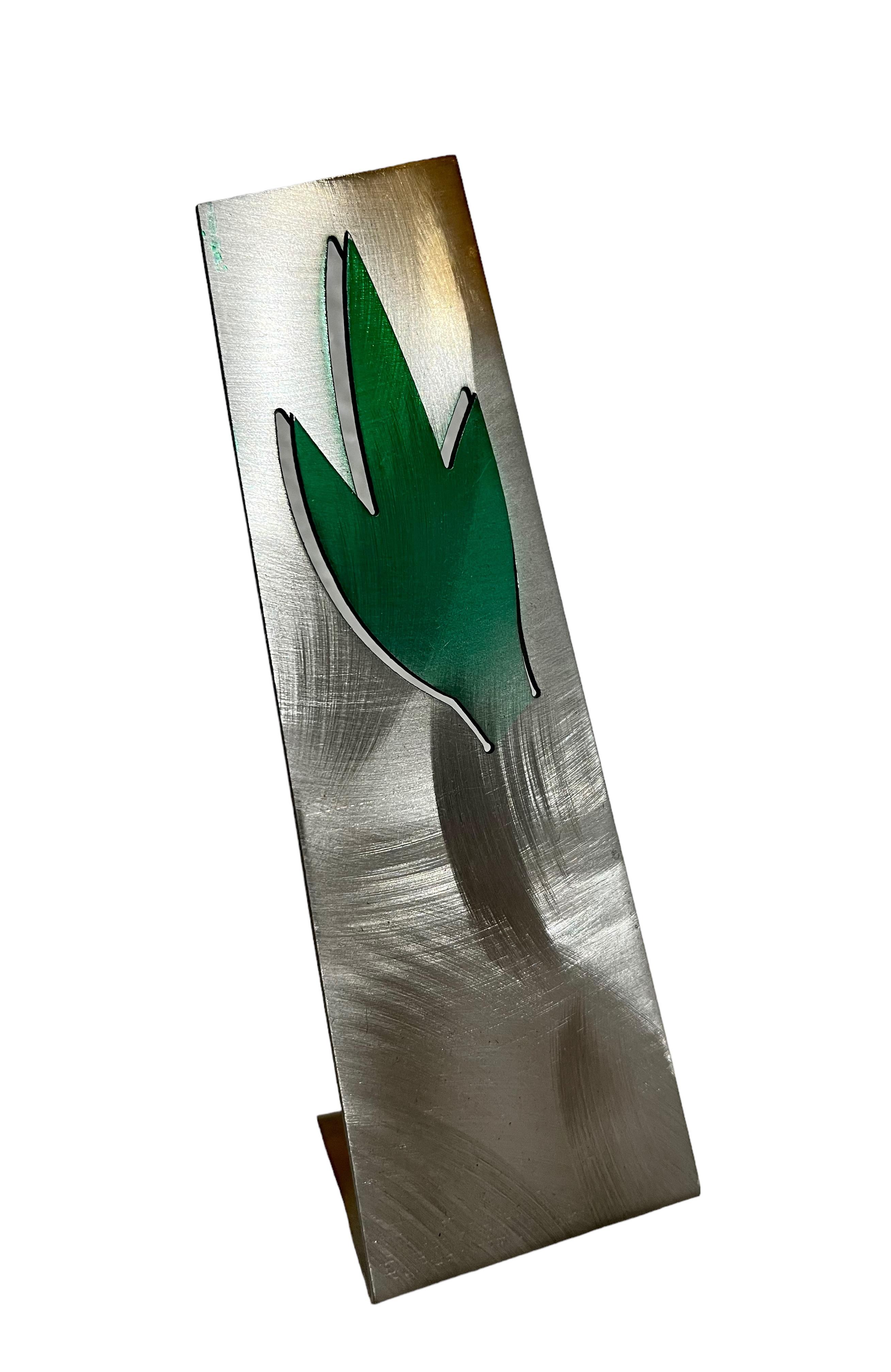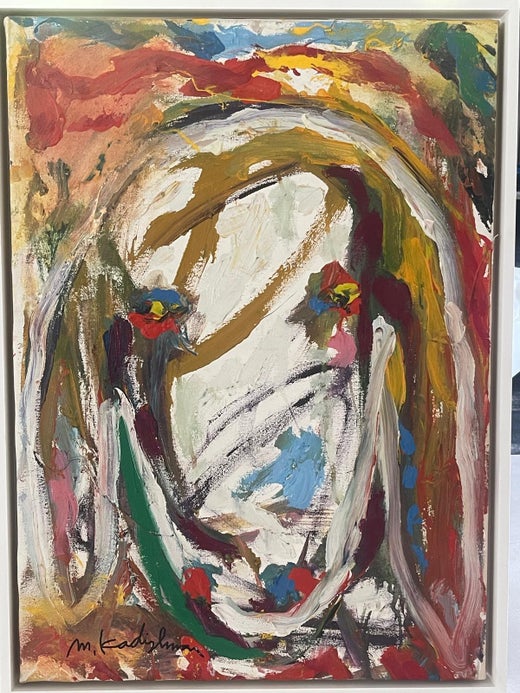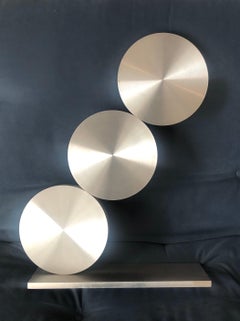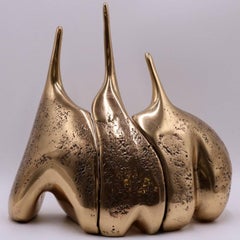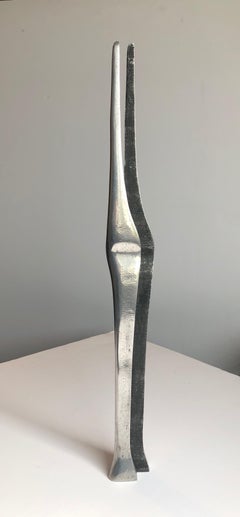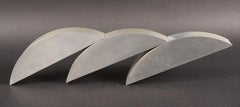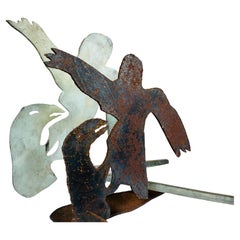Items Similar to Israeli Pop Art Abstract Cutout Trees Kinetic Gilt Sculpture Menashe Kadishman
Want more images or videos?
Request additional images or videos from the seller
1 of 21
Menashe KadishmanIsraeli Pop Art Abstract Cutout Trees Kinetic Gilt Sculpture Menashe Kadishmanc.1970's
c.1970's
$6,500
£4,902.68
€5,662.64
CA$9,106.95
A$10,126.40
CHF 5,301.35
MX$123,695.91
NOK 66,616.75
SEK 62,666.40
DKK 42,271.24
About the Item
Renowned Israeli sculptor Menashe Kadishman (1932-2015),
CONTINUUM, 1979,
revolving metal sculpture,
Dimensions 16.5 x 10 x 9.25 inches.
Hand signed and numbered on dedication plaque mounted to the underside, 18 from edition of 50
gilt bronze or steel rotating on base, etched signed, titled, dated, and numbered 18/50,
This sculpture is a replica (maquette) in smaller scale of a 20' monumental sculptures that was commissioned by the Weizmann Institute and installed in October 1979 on the campus of the Weizmann Institute of Science in Rehovot, Israel. The main part of the sculpture rotates on a stationary square piece of brass.
Published For The Benefit of Harry Levine/ Weizmann Institute of Science
Menashe Kadishman was born in Tel-Aviv in 1932. He is a Graduate of St. Martin's School of Art, University of London. From 1947 to 1950, Kadishman studied with the Israeli sculptor Moshe Sternschuss at the Avni Institute of Art and Design in Tel Aviv, and in 1954 with the Israeli sculptor Rudi Lehmann in Jerusalem. In 1959, he moved to London, where he remained until 1972. He had his first one-man show there in 1965 at the Grosvenor Gallery. His sculptures of the 1960s were Minimalist in style and so designed as to appear to defy gravity. This was achieved either through careful balance and construction, as in Suspense (1966), or by using glass and metal so that the metal appeared unsupported, as in Segments (1968). In 1995, he began painting portraits of sheep. These instantly-recognizable sheep portraits soon became his artistic trademark. In 1990, Kadishman was awarded the Dizengoff Prize for Sculpture and in 1995 he was awarded the Israel Prize, for sculpture. Kadishman was an America-Israel Cultural Foundation scholarship recipient from 1960-1962.
Menashe Kadishman was born in Tel-Aviv in 1932. He is a Graduate of St. Martin's School of Art, University of London Studies with Anthony Caro, Reg Butler. From 1947 to 1950, Kadishman studied with the Israeli sculptor Moshe Sternschuss at the Avni Institute of Art and Design in Tel Aviv, and in 1954 with the Israeli sculptor Rudi Lehmann in Jerusalem. In 1959, he moved to London, where he remained until 1972. He had his first one-man show there in 1965 at the Grosvenor Gallery. His sculptures of the 1960s were Minimalist in style and so designed as to appear to defy gravity. This was achieved either through careful balance and construction, as in Suspense (1966), or by using glass and metal so that the metal appeared unsupported, as in Segments (1968). In 1995, he began painting portraits of sheep. These instantly-recognizable sheep portraits soon became his artistic trademark. Along with Reuven Rubin and Yaacov Agam he is one of Israel's most famous artists. In 1990, Kadishman was awarded the Dizengoff Prize for Sculpture and in 1995 he was awarded the Israel Prize, for sculpture. This was from a portfolio that included Ivan Schwebel, Michael Gross, Liliane Klapisch and Moshe Kupferman, five of Israel's leading contemporary artists who were each approached in May 1977 with a request to contribute a hand-printed screenprint for a portfolio to be titled "Jerusalem". The sole term of reference was the name "Jerusalem", with no qualifications at all. The five artists then spent time working completely independently and individually on the project at the Jerusalem Print Workshop. Each screenprint was hand-signed by their respective artist and numbered from the edition of 200, hand-printed on BFK Rives paper Published by Whartman and Sacks Art Publications
Kadishman was an America-Israel Cultural Foundation scholarship recipient from 1960-1962.
Selected one man exhibitions
1965 Kadishman, Sculptures - Grosvenor Gallery, London. Charles Spencer
Harlow Arts Festival - Harlow, England
1967 Dunkelman Gallery, Toronto
1968 Edinburgh International Festival - Goldbergs & The Richard Demarco Gallery
1970 Menashe Kadishman / Yellow Forest - Jewish Museum, New York. Cur. Tejas Englesmith, asso. curator Edward Fry
1971 The J.L. Hudson Gallery, Detroit, Michigan
1972 Menashe Kadishman, Concepts and their realization - Mus. Haus Lange, Krefeld. Cur. Paul Wember
Yellow Square, Valley of the Cross, Jerusalem
1975 Canvas Forest/Laundry - Israel Museum, Jerusalem. Curator Yona Fisher
Menashe Kadishman : Glass - Julie M. Gallery, Tel Aviv
1976 M. Kadishman : Glass - Rina Gallery, New York
1977 Unicorn Gallery, Copenhagen
1978 The Venice Biennale, The Israeli Pavilion. Curator Amnon Barzel
Select Group Exhibitions
Genia Schreiber University Art Gallery, Tel Aviv
Abramson, Larry Avigdor Arikha, Dei Ben Shaul, David Michail Grobman, Michael Gross, Uri Lifschitz, Ofer Lellouche, Menashe Kadishman, Shaul Schatz and others.
Israel Pollak School of Art Kalisher Five, Art Sc, Tel Aviv
Abramson, Larry Menashe Kadishman, Pinchas Cohen Gan, David Reeb, Arnon Ben David, Moshe Gershuni and other.
General Exhibition, Art in Israel 1960 Tel Aviv Museum of Art
Artists: Naftali Bezem, Nachum Gutman, Shraga Weil, Shraga, Marcel Janco, Ruth Schloss.
Yad Labanim Museum, Petach Tikva with David Azuz, Nachum Gutman, Moshe Gat, Shraga Weil, Lea Nikel, Ruth Schloss, Yosl Bergner, Anna Ticho, Menashe Kadishman.
Old and New in the Museum Collection, Yad Labanim Museum, Petach-Tikva
Jacob El Hanani, Naftali Bezem, Yosl Bergner, Yossef Zaritsky, Yohanan Simon, Reuven Rubin, David Rakia, Hermann Struck, Jakob Steinhardt, Boris Schatz, and others.
Selected one man exhibitions
1965 Kadishman, Sculptures - Grosvenor Gallery, London. Curator Charles Spencer
Harlow Arts Festival - Harlow, England
1967 Dunkelman Gallery, Toronto
1968 Edinburgh International Festival - Goldbergs & The Richard Demarco Gallery
1970 Menashe Kadishman / Yellow Forest - Jewish Museum, New York. Cur. Tejas Englesmith, asso. curator Edward Fry
1971 The J.L. Hudson Gallery, Detroit, Michigan
1972 Menashe Kadishman, Concepts and their realization - Mus. Haus Lange, Krefeld. Cur. Paul Wember
Yellow Square, Valley of the Cross, Jerusalem
1975 Canvas Forest/Laundry - Israel Museum, Jerusalem. Curator Yona Fisher
Menashe Kadishman : Glass - Julie M. Gallery, Tel Aviv
1976 M. Kadishman : Glass - Rina Gallery, New York
1977 Unicorn Gallery, Copenhagen
1978 The Venice Biennale, The Israeli Pavilion. Curator Amnon Barzel
- Creator:Menashe Kadishman (1932, Israeli)
- Creation Year:c.1970's
- Dimensions:Height: 16.5 in (41.91 cm)Width: 9.25 in (23.5 cm)Depth: 10 in (25.4 cm)
- Medium:
- Movement & Style:
- Period:
- Condition:good, minor surface wear commensurate with its age and technique.
- Gallery Location:Surfside, FL
- Reference Number:1stDibs: LU38216104882
Menashe Kadishman
Menashe Kadishman was born in Mandate Palestine. His father died when he was 15 years old. He left school to help his mother and provide for the family.[1] From 1947 to 1950, Kadishman studied with the Israeli sculptor Moshe Sternschuss at the Avni Institute of Art and Design in Tel Aviv, and in 1954 with the Israeli sculptor Rudi Lehmann in Jerusalem. In 1950–1953, Kadishman worked as a shepherd on Kibbutz Ma'ayan Baruch. This experience with nature, sheep and shepherding had a significant impact on his later artistic work and career. In 1959, Kadishman moved to London to study at Saint Martin's School of Art and the Slade School of Art.[2] In 1959-1960 he also studied with Anthony Caro and Reg Butler.[2] He had his first one-man show there in 1965 at the Grosvenor Gallery. In 1972, he returned to Israel. In the 1960s, Kadishman's sculptures were Minimalist in style, and so designed as to appear to defy gravity. This was achieved either through careful balance and construction, as in Suspense (1966), or by using glass and metal so that the metal appeared unsupported, as in Segments (1968). The glass allowed the environment to be part of the work. The first major appearance of sheep in his work was at the 1978 Venice Biennale, where Kadishman presented a flock of colored live sheep as living art.[4] In 1995, he began painting portraits of sheep by the hundreds, and even thousands, each one different from the next. These instantly-recognizable sheep portraits soon became his artistic "trademark"
About the Seller
4.9
Platinum Seller
Premium sellers with a 4.7+ rating and 24-hour response times
Established in 1995
1stDibs seller since 2014
1,799 sales on 1stDibs
Typical response time: <1 hour
- ShippingRetrieving quote...Shipping from: Surfside, FL
- Return Policy
Authenticity Guarantee
In the unlikely event there’s an issue with an item’s authenticity, contact us within 1 year for a full refund. DetailsMoney-Back Guarantee
If your item is not as described, is damaged in transit, or does not arrive, contact us within 7 days for a full refund. Details24-Hour Cancellation
You have a 24-hour grace period in which to reconsider your purchase, with no questions asked.Vetted Professional Sellers
Our world-class sellers must adhere to strict standards for service and quality, maintaining the integrity of our listings.Price-Match Guarantee
If you find that a seller listed the same item for a lower price elsewhere, we’ll match it.Trusted Global Delivery
Our best-in-class carrier network provides specialized shipping options worldwide, including custom delivery.More From This Seller
View AllLarge 1970's Israeli Abstract Sculpture Steel Menashe Kadishman Tel Aviv Uprise
By Menashe Kadishman
Located in Surfside, FL
Hitromemut (Uprise)
Beautiful large sculpture by renowned Israeli sculptor Menashe Kadishman. Super quality, and visually stunning. There is a large monumental version of this in fro...
Category
1970s Abstract Geometric Abstract Sculptures
Materials
Stainless Steel
Rare Aharon Bezalel Israeli Gilt Modernist Bronze Sculpture Suite
By Aharon Bezalel
Located in Surfside, FL
The width dimensions are variable. the tallest height is 11.5 inches. Family group. A suite of three bronze sculptures.
Aharon Bezalel (born Afghanistan 1926) Born in Afghanistan in 1926 and immigrated to Israel at an early age. As a youth was engaged as a silversmith and craftsman, and was a student of the sculptor Zev Ben-Zvi from whom he absorbed the basic concepts of classic and modernist art and interpreted, according to them, ideas based on ancient Hebrew sources.
Aharon Bezalel works and resides in Jerusalem, he taught art for many years.
“I saw myself as part of this region. I wanted to find the contact between my art and my surroundings. Those were the first years of Jean Piro’s excavations at the Beer-Sheba mound. They found there, for example, the Canaanite figurines that I especially liked and that were an element that connected me with the past and with this place.” “…a seed and sperm or male and female. These continue life. The singular, the individual alone, cannot exist; I learned this from my father who dabbled with the Kabbalah.”
(Aharon Bezalel, excerpt from an interview with David Gerstein)
“The singular in Aharon Bezalel’s work is always potentially a couple if not a threesome[…] the one is also the many: when the individual is revealed within the group he will always seek a huddling, a clinging together.
The principle of modular construction is required by this perception of unity and multiplicity, as modular construction in his work is an act of conception or defense.
Two poles of unity, potentially alone, exist in A. Bezalel’s world: From a formal, sculptural sense these are the sphere and pillar, metaphorically these are the female in the final stages of pregnancy and the solitary male individual. Sphere-seed-woman; Pillar-strand-man. The disproportional, small heads in A. Bezalel’s figures leave humankind in it’s primal physical capacity. The woman as a pregnancy or hips, the man as an aggressive or defensive force, the elongated chest serves as a phallus and weapon simultaneously.
(Gideon Ofrat)
EIN HAROD About the Museum's Holdings: Israeli art is represented by the works of Reuven Rubin, Zaritzky, Nahum Gutman, Mordechai Ardon, Aharon Kahana, Arie Lubin, Yehiel Shemi, Yosl Bergner and others.
The graphic arts collection contains drawings and graphic works by Pissaro, Modigliani, Pascin, Chagall (almost all of his graphic work), and numerous other artists. The sculpture collection includes works by Jewish sculptors from all over the world including leading Israeli sculptors; Ben Zvi, Lishansky, David Palombo, Yehiel Shemi, Aharon Bezalel and Igael Tumarkin.
Many Jewish sculptors from all parts of the world, beginning with Antokolski, are represented in the collection. In the sculpture courtyard there are works by Chana Orloff, Jacob Epstein (the works he bequeathed to the Museum), Glicenstein, Loutchansky, Constant and Indenbaum from Western Europe; Glid from Yugoslavia; Zorach, Gross and Harkavy from the United States; and most of the outstanding sculptors of Israel : Ben-Zvi, Lishansky, Ziffer, Lehmann, Feigin, Sternschuss, Palombo ( who executed the iron gate...
Category
1970s Expressionist Abstract Sculptures
Materials
Bronze
Aharon Bezalel Israeli Modernist Sculpture 2 Parts Minimalist Aluminum or Steel
By Aharon Bezalel
Located in Surfside, FL
A suite of 2 sculptures. Lovers, man and woman nestled together. sleek minimalist mod sculpture.
polished finish on one side. not sure if theese are stell or aluminium. they are cast and signed in Hebrew with initials and numbered 9/9. It is 2 parts that nest together.
Aharon Bezalel (born Afghanistan 1926) Born in Afghanistan in 1926 and immigrated to Israel at an early age. As a youth was engaged as a silversmith and craftsman, and was a student of the sculptor Zev Ben-Zvi from whom he absorbed the basic concepts of classic and modernist art and interpreted, according to them, ideas based on ancient Hebrew sources.
Aharon Bezalel works and resides in Jerusalem, he taught art for many years.
“I saw myself as part of this region. I wanted to find the contact between my art and my surroundings. Those were the first years of Jean Piro’s excavations at the Beer-Sheba mound. They found there, for example, the Canaanite figurines that I especially liked and that were an element that connected me with the past and with this place.” “…a seed and sperm or male and female. These continue life. The singular, the individual alone, cannot exist; I learned this from my father who dabbled with the Kabbalah.”
(Aharon Bezalel, excerpt from an interview with David Gerstein)
“The singular in Aharon Bezalel’s work is always potentially a couple if not a threesome, the one is also the many: when the individual is revealed within the group he will always seek a huddling, a clinging together.
The principle of modular construction is required by this perception of unity and multiplicity, as modular construction in his work is an act of conception or defense.
Two poles of unity, potentially alone, exist in Aaron Bezalel’s world: From a formal, sculptural sense these are the sphere and pillar, metaphorically these are the female in the final stages of pregnancy and the solitary male individual. Sphere-seed-woman; Pillar-strand-man. The disproportional, small heads in Aharon Bezalel’s figures leave humankind in it’s primal physical capacity. The woman as a pregnancy or hips, the man as an aggressive or defensive force, the elongated chest serves as a phallus and weapon simultaneously.
(Gideon Ofrat)
EIN HAROD About the Museum's Holdings: Israeli art is represented by the works of Reuven Rubin, Zaritzky, Nahum Gutman, Mordechai Ardon, Aharon Kahana, Arie Lubin, Yehiel Shemi...
Category
1970s Minimalist Abstract Sculptures
Materials
Metal
60s Kadishman Israeli sculpture in steel or aluminum Suspension
By Menashe Kadishman
Located in Surfside, FL
Beautiful table top sculpture by renowned Israeli sculptor Menashe Kadishman. Super quality, and visually stunning. it is signed and numbered and dedicated Janet love george
Menashe ...
Category
1960s Modern Abstract Sculptures
Materials
Stainless Steel
Rare 1970 Israeli Abstract Sculpture Steel Menashe Kadishman Suspension
By Menashe Kadishman
Located in Surfside, FL
Beautiful table top sculpture by renowned Israeli sculptor Menashe Kadishman. Super quality, and visually stunning. There is a large sculpture of his in Rabin Square in the heart of ...
Category
1970s Abstract Geometric Abstract Sculptures
Materials
Stainless Steel
Israeli Contemporary Abstract Geometric Painted Pierced Sculpture Zigi Ben Haim
By Zigi Ben-Haim
Located in Surfside, FL
Zigi Ben-Haim,
Metal sculpture
Hand signed and dated Zigi Ben-Haim, 1998
Untitled, patinated aluminum or steel,
Dimensions: 6"h x 2"w x 2"d
This listing is for 1. I have 2 similar ones available.
Zigi Ben-Haim (born 1945 in Baghdad, Iraq) is an Iraqi-American-Israeli painter, collage artist and sculptor who lives and works in New York City and Israel.
Ben-Haim unveiled his sculpture, Treasure the Green, in SoHo on Broadway. The project was sponsored by the SoHo Broadway Initiative and the New York Department of Transportation's Art Program. The sculpture is considered to be the first sculpture to receive permission to be installed on a bus bulb on Broadway. The sculpture was made to "emphasize the importance of nature in our lives," and stands as a reminder of "the importance of reconnecting with the pure nature of the green." The sculpture uses the symbol of the leaf, which has been a major icon of Ben-Haim's work for the past 30 years. It symbolizes nature and it is a metaphoric way of emphasizing nature and the surrounding environment. He is of the first generation of Israeli artists to develop large international followings like Yaacov Agam, Menashe Kadishman and Avigdor Arikha.
Ben-Haim has received numerous grants and awards, including from Pollock-Krasner Foundation, National Endowments for the Arts, New York State Council on the Arts, The German Academic Exchange Service (DAAD), Emily Harvey Foundation Venice, Muestra Int. de Obra Grafica (Spain), and the Ministry of Culture in Israel. His works are included and exhibited in numerous public and private collections around the world, including the Guggenheim Museum in N.Y.C., the Jewish Museum, the Brooklyn Museum, the Israel Museum, and the Tel-Aviv Museum.
Education
1972-74 M.F.A., San Francisco State University, San Francisco, California, USA.
1972-73 M.A., J.F.K. University, Orinda, California, USA.
1971 California College of Arts & Crafts, Oakland, California, USA.
1966-70 The Avni Institute of Fine Arts, Tel Aviv, Israel.
Selected public collections
Splendid Step (2003) next to the Tel Aviv Museum of Art
Museum of Contemporary Art, Athens, Greece
Columbia Museum of Art, Columbia, SC
Israel Air Force Center Foundation, Tel Aviv, Israel
NASA, Houston, Texas
Bank Leumi USA, Fifth Avenue, New York, NY
Pfizer Company Collection, New York, NY
Reading Public Museum, Reading, PA
Guggenheim Museum, New York, NY
Haifa Museum, Haifa, Israel
Herbert F. Johnson Museum of Art, Cornell University, Ithaca, NY
New School, New York, NY
University of Maryland, College Park, Maryland.
Israel Museum, Jerusalem, Israel.
Brooklyn Museum, Brooklyn, NY
Malmö Museum, Malmö, Sweden.
Jewish Museum, New York, NY
Tel Aviv Museum of Art, Tel Aviv, Israel.
Museum of Fine Arts, Ghent, Ghent, Belgium.
National Gallery of Art, Washington D.C.
Fine Arts Museum of Long Island, Hempstead, NY
Buscaglia-Castellano, University Museum, Lewiston, NY
Dan Eilat Hotel, Israel.
International Paper Company, New York, NY
World Bank, Washington D.C.
Westminster Bank, New York, NY
Israel Embassy, Washington D.C.
Frederick R. Weisman, Los Angeles, CA.
Rikers Hill Sculpture Park, Livingston, NJ
Heckscher Museum of Art, Huntington, NY
Allen Memorial Art Museum, Oberlin College, Oberlin, Ohio
Group Exhibitions
Bertha Urdang Gallery, NY, USA
Artists: Larry Abramson, Yosef Zaritsky, Zelig Segal...
Category
1980s Abstract Geometric Abstract Paintings
Materials
Metal
You May Also Like
Tree in Tree (Red and Orange), Conceptual Screenprint by Menashe Kadishman
By Menashe Kadishman
Located in Long Island City, NY
Artist: Menashe Kadishman, Israeli (1932 - 2015)
Title: Tree in Tree (Red and Orange)
Year: 1979
Medium: Screenprint, signed and numbered in pencil
Edition: 125
Size: 41 x 30...
Category
1970s Conceptual Abstract Prints
Materials
Screen
Menashe Kadishman Prototype Artist Proof Torch Cut Steel Sculpture Pair
By Menashe Kadishman
Located in Southampton, NJ
A pair of Menashe Kadishman small scale artist proof prototypes from the estate of Tamar and her husband renowned Princeton professor Ted (Theodore) Rabb who knew him personally. At ...
Category
Mid-20th Century American Mid-Century Modern Abstract Sculptures
Materials
Cut Steel
1980 Italy Bronze Abstract Sculpture by Lino Tiné Albero Città City Tree
Located in Brescia, IT
This intense and engaging abstract sculpture was create in 1980 by the Italian artist Lino Tinè.
This is a multiple of 300 specimens, numbered and signed by the artist. The title is ...
Category
Late 20th Century Post-Modern Abstract Sculptures
Materials
Bronze
1980 Italy Bronze Abstract Kinetic Sculpture Bruno Chersicla Alambicco Still
By Bruno Chersicla
Located in Brescia, IT
This sculpture is a multiple 1 piece of 1000 realized in 1980 by the well known Italian artist Bruno Chersicla.
All the pieces are numbered and signed by the artist and completed by ...
Category
Late 20th Century Post-Modern Abstract Sculptures
Materials
Bronze
Tree Abstract, Serigraph by Menashe Kadishman
By Menashe Kadishman
Located in Long Island City, NY
Artist: Menashe Kadishman, Israeli (1932 - 2015)
Title: Tree in Tree
Year: 1979
Medium: Serigraph, signed and numbered in pencil
Edition: 125
Size: 41 x 30 in. (104.14 x 76....
Category
1970s Conceptual Abstract Prints
Materials
Screen
Abstract Aluminum Sculpture by Menashe Kadishman
By Menashe Kadishman
Located in New York, NY
An aluminum modern sculpture by Menashe Kadishman (1932-2015) entitled Checkpoint (In Suspense). From a limited edition of six issued in 19...
Category
Vintage 1970s Israeli Mid-Century Modern Sculptures
Materials
Aluminum
More Ways To Browse
Laundry Art
Small Brass Sculpture
Metal Tree Sculptures
Bronze Sculpture Tree
Tree Glass Sculpture
Sheep Sculpture
Glass Sculpture Etched Glass
Award Plaque
Vintage Sacks
Israeli Brass
Metal Sheep
Old Bronze Cross
Unicorn Sculpture
Shraga Weil
Bronze Unicorn
London Midland And Scottish Railways
Michael Swan
Oil Teddy Bear
